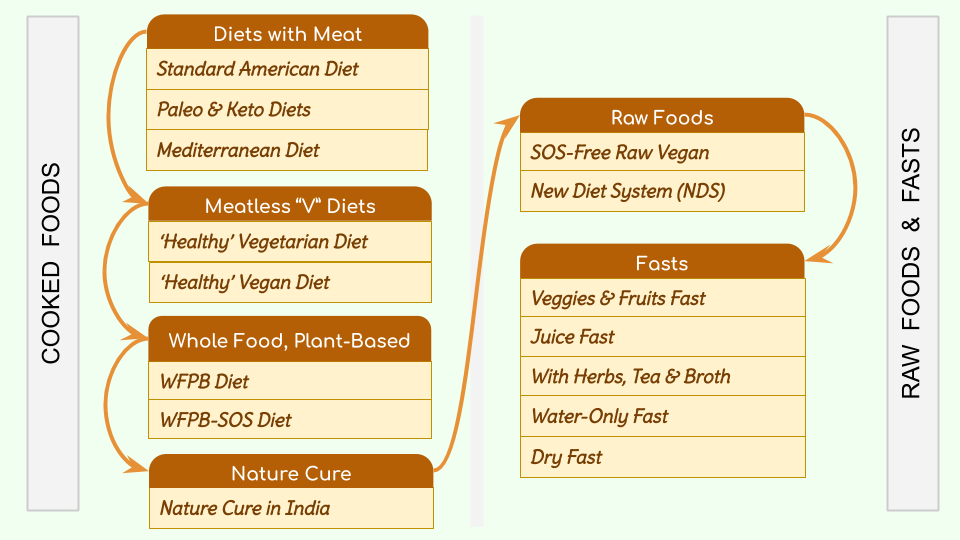When we start adopting more and more refined diets, and when we practice short-term fasts, we may think that we're affecting only our physical health. However, we unwittingly embark on an emotional journey and a spiritual journey as well! Let us see how.
Ancient Indians divided food into Tamasic, Rajasic and Sattvic. Tamasic food promotes negative states of mind characterized by negative emotions: {anger, hatred, fear, anxiety, …}. Sattvic food promotes positive states of mind characterized by positive emotions: {calmness, peacefulness, joy, …}. I have not been able to find an 'official' / 'agreed upon' definition of Tamasic and Sattvic food ingredients or methods of preparation. But my general understanding is that WFPB-NO foods and Nature Cure (Naturopathy) foods (when prepared with fresh ingredients and eaten fresh, without too many spices, especially without chillies) are close to Sattvic Indian foods! Various non-compliant ingredients and methods of food preparation which are common in non-WFPB foods are all Tamasic!
Perspectives on Dairy is an article by Dr Gabriel Cousens that explains why milk is Tamasic in the modern world. Who is Gabriel Cousens? He runs the Tree of Life Center in Tennessee, USA. And he has a fascinating biography. He advocates WFPB food habits but leans towards raw. He is a general physician, a psychiatrist, a counselor, a Kundalini yoga teacher (he spend several years in India with two gurus), Ayurveda teacher, a Jewish rabbi, a shaman. He has also studied at the Shaolin temple in China; he's a 4-year Native American Sundancer, Eagle Dancer, and Spirit Dance clan chief in the High Horse Lakota clan (I don't know what this means). Basically, I see him as somebody unique with a fair amount of knowledge from multiple healing traditions.
How may you verify in yourself that Tamasic and Sattvic foods promote negative and positive states of mind? Well, if you have some experience with meditation, you may be able to observe your thoughts and emotions in third person at various points of time during a day. Start connecting dots over time — what foods are you eating over a week, what foods are you craving for, and what emotions are you experiencing that week. Make written notes, if needed. If you're not skillful at observing your thoughts and emotions in third person, then you can use apps to remind you to write your down your general state of being over the course of a day every evening. Again, the goal is to start connecting these dots in yourself to see if the Tamasic - Sattvic theory is true for you or not.
It must also be noted that many people are able to maintain their calmness even after consuming Tamasic foods. Traditional Buddhist monks, for example, consume whatever falls into their bowl. Taking this to the extreme, there are first hand reports of saints like Neem Karoli Baba ingesting deadly substances without anything happening to him. Neem Karoli Baba is the saint whose shrine in India has been visited by Larry Page (Google founder), Jeffrey Skroll (co-founder of EBay), Mark Zuckerberg (FaceBook founder) and Steve Jobs (Apple co-founder).
So on the whole, my big picture understanding is the following: our state of mind is influenced by the food we consume and also by our skill level at maintaining calmness. So what do I do? Since my skill level does not match Buddhist monks and saints, my personal strategy is to consume Sattvic foods whenever possible; they make our job of maintaining calmness easier.
The teachings of Ramana Maharshi (1879 - 1950) are encapsulated in a small booklet, Who Am I?. This booklet is in question and answer format. In response to Question 12, he says, "Of all the restrictive rules, that relating to the taking of sattvic food in moderate quantities is the best". What does this mean? In Question 12, he's helping us understand how to quieten the mind.
My personal understanding is that Ramana Maharshi didn't advocate any specific technique for quietening the mind and that his main teaching (which are the final few steps towards understanding Advaita Vedanta) can be grasped much more easily if an individual has applied whatever technique works for them to acquire one-pointedness (calming the mind to such an extent that you are able to focus on one thing only: the object of meditation).
There are myriad schools and myriad techniques for quietening the mind. But among various 'restrictions' found in these techniques, Ramana Maharshi advocated only one:
"Eat simple, sattvic food in moderate quantities."
Isn't it fascinating that Ramana Maharshi isolated and highlighted one specific guideline / rule among all the 'restrictive' rules found in myriad schools of meditation! He had concluded that this guideline was the most effective aid towards quietening the mind (at least temporarily).
When we switch from non-WFPB foods to simple WFPB-NO foods, our mind starts calming down. Such calming down and relaxation can be triggered through other means too (some are mildly effective, some are potent): just spending time in nature for many days; simply relaxing at home and doing nothing for several days; meditation retreats; even love making (when done properly) is super relaxing.
An interesting phenomenon is that when we start to relax, we sometimes start remembering our past. In fact, the deeper we allow ourselves to relax, the more the chances that we will unearth traumas buried inside us. What happens? We start thinking about these past events… At the same time, we start experiencing emotions associated with these past experiences and we start experiencing bodily sensations associated with these past experiences. Sometimes, we have conscious memories of these past events in vivid detail. Sometimes, we don't have conscious memories but we experience 'abstract anger' or 'abstract fear' or 'abstract anxiety'. The same phenomenon can be triggered through psychotherapy or hypnotherapy too.
When past memories or past traumas get triggered, it is actually a golden opportunity for resolution (which means that we can come to terms with it and get cured of the trauma). But we need to be armed with the right techniques, otherwise we fortify and worsen the trauma. Now what are these techniques and where are these techniques taught? In the modern world, there are at least two good sources. A large number of tools and techniques have been developed in modern psychology. Some examples are forgiveness workshops, journaling, Cognitive Behavioral Therapy, various mindfulness-based therapies, deaddiction programs, bereavement counseling, and other specialized techniques for specific situations and traumas. Alternately, here are spiritual techniques (Vipassana meditation or mindfulness is one of them; it is very potent). In my opinion, both sources of tools and techniques are valuable — I encourage my friends to learn them, try them out and see what works for them.
Now if you have already worked on yourself and resolved at least the known past traumas by applying modern psychology techniques or spiritual techniques, and you're generally calm and joyful, then switching from non-WFPB to WFPB or WFPB-NO foods will be a cakewalk :) It's pretty straightforward. But if you're still carrying the burden of negative past experiences which are yet to be resolved, there is the possibility of encountering emotional challenges when you make the switch from non-WFPB to WFPB (or WFPB-NO) food habits.
I may have used strong words like 'trauma' in the passages above but that's how I understand the big picture. Many times, the underlying reason for poor eating habits is psychological. See this article in Huffington Post: ACE Study (Adverse Childhood Experiences), for example. Many times, incidents in adult life trigger emotional eating. For example, here is a quote from the article Why Obesity Is Often a Symptom of a Deeper Pain by Dr Mondo:
“If you want to change your long-standing relationship to comfort eating you must do two things.First, you must be willing to dig deep and explore the recurring pain that ve been using food to escape, numb or find comfort in. Second, you must engage in that exploration from a place of compassion for yourself, rather than shame. When you explore the emotion behind your comfort eating you will discover a context that finally allows your wild relationship with food to actually make perfect sense.
Trigger emotions are the biggest clues that we have for tracing our way back to the real pain. What feelings triggers eating for comfort? Maybe it's anxiety, or loneliness, or depression; maybe it's the fear of abandonment, fear of rejection, or fear of failure — or a combination of several of those feelings. Identify what your trigger emotions are and then spend some time examining the backstory of your relationship to that feeling. When did it first show up? In what relationships or settings?”
As we start cleaning up our eating habits and start becoming calmer, memories of events that triggered poor eating habits in the first place are likely to surface; it is these memories that are accompanied by negative emotions and bodily sensations. So we need tools and techniques to counter these situations.
Here is what Dr Bulsiewicz says at offset 5:25 of his podcast interview with Rich Roll (2020):
"The most challenging patients that I see as a gastroenterologist are the people who have been victims of physical, emotional, sexual, psychological trauma. It changes them and they don't realize the way that it affects their guts. And typically, when they get to me, I'm the 5th or 6th doctor (gastroenterologist) they've been to; they're looking for solutions related to their gut microbiome or to their digestive issues; and what i discover after getting to know them and building trust in that relationship, is that the solution is not through food but more so it's actually healing that trauma that's eating at them at a subconscious level."
The Tamonata Sutra by Buddha is very simple:
"There are these four types of people to be found existing in the world. Which four? One in darkness who is headed for darkness, one in darkness who is headed for light, one in light who is headed for darkness, and one in light who is headed for light."
I feel that somebody who gravitates towards a Whole-Food Plant-Based (WFPB or WFPB-NO) food is headed for light, as explained in this article. But such a journey might entail going through emotional turmoil. It may sound strange but it is possible to develop gratefulness for these moments of turmoil because they are actually golden opportunities for resolution! But resolution is possible only if we are armed with the right set of skills and techniques for achieving such resolution. These skills may be spiritual in nature, or learnt through modern psychology. As we keep resolving such turmoil using the right techniques and skills, we keep becoming more and more relaxed, more and more peaceful and joyful; in some sense, we are progressively overcoming our own demons; it is in this sense that we move towards light!

 Instagram
Instagram YouTube
YouTube